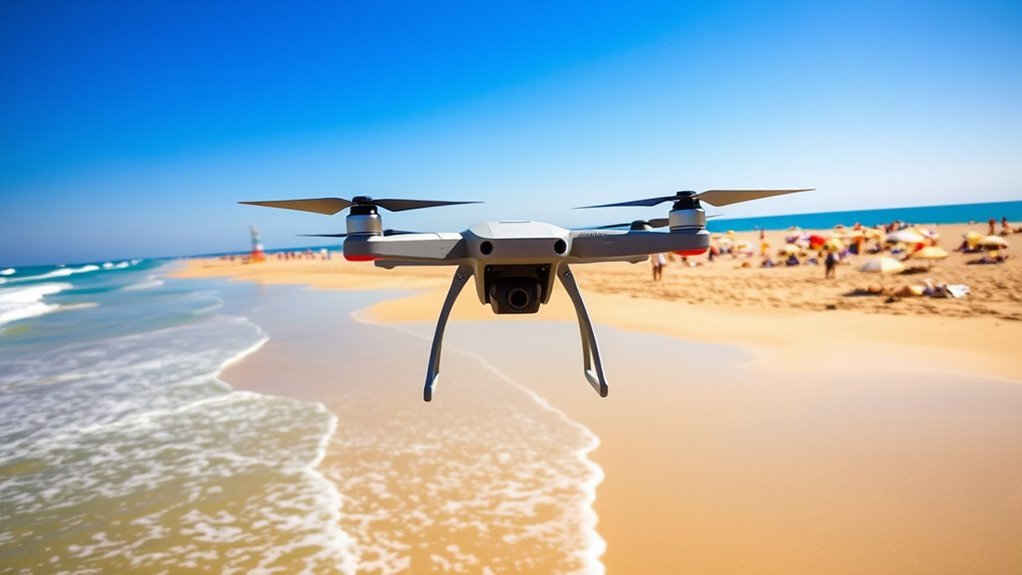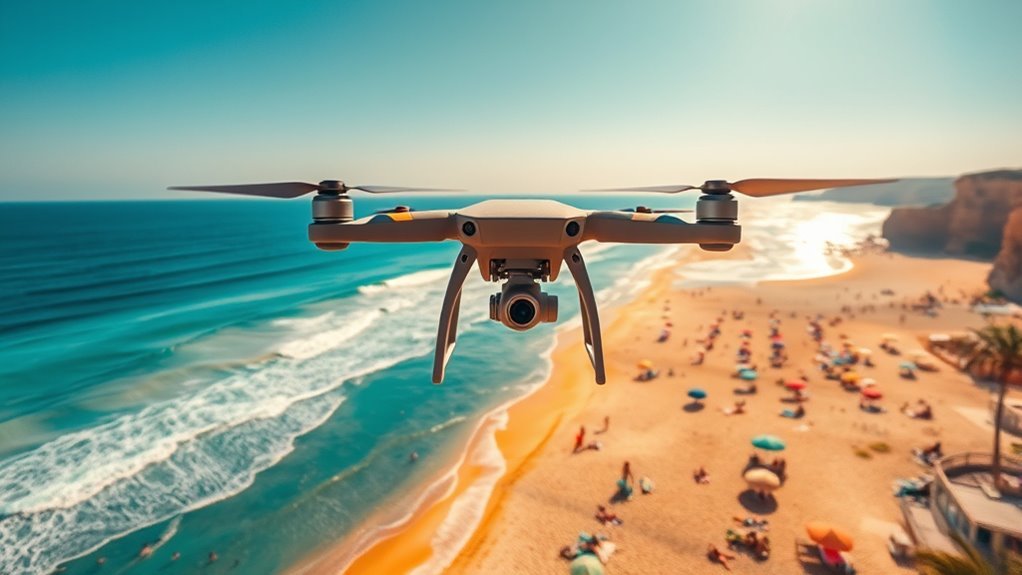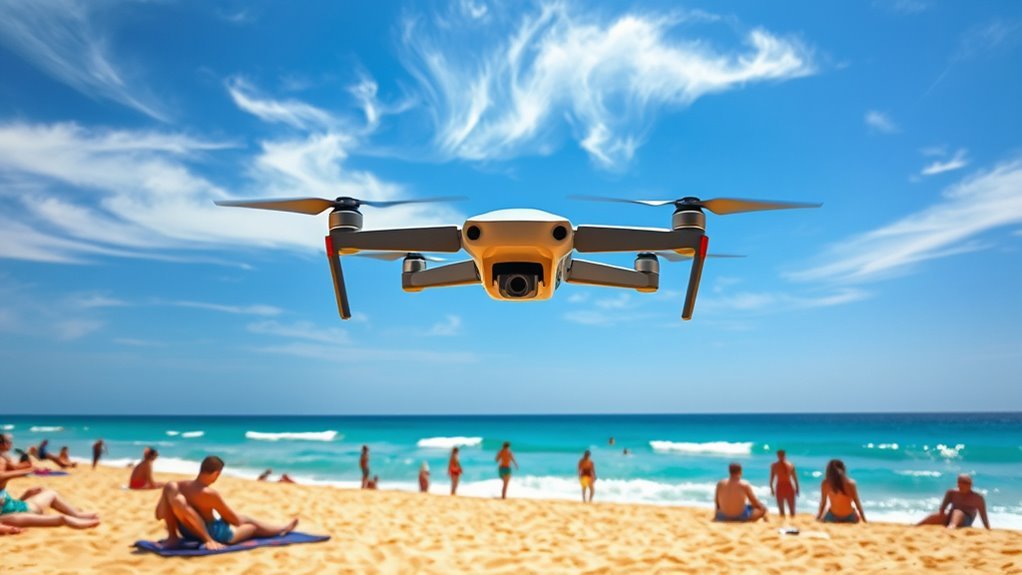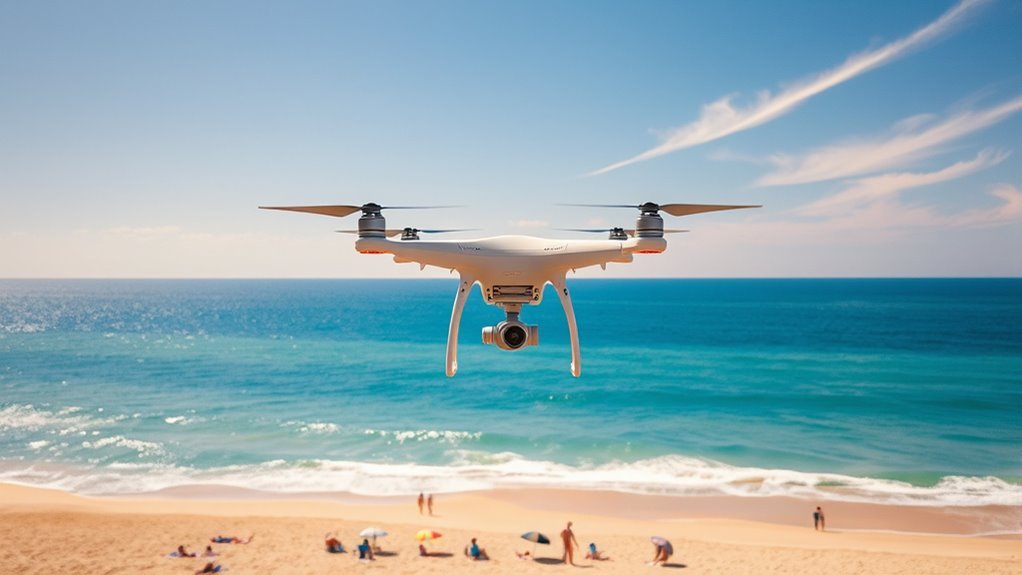You can fly drones at the beach, but it’s crucial to know local regulations first. Many beaches have specific rules, including no-fly zones and requirements for permits or insurance. Always prioritize safety by respecting others’ space, staying clear of wildlife, and keeping an eye on battery levels. To capture stunning aerial shots, consider the ideal times and techniques for photography. For a deeper understanding of this topic, you can discover more important information.
Understanding Local Regulations

When you’re considering flying a drone at the beach, it’s vital to understand local regulations that may affect your plans. Each beach can have different rules regarding drone use, often enforced by local authorities. Before you launch, check for any restrictions, such as designated no-fly zones or specific hours for flying. Some areas might require permits or drone insurance to operate legally. Local enforcement can issue fines or confiscate your drone if you violate these regulations, so staying informed is important. Additionally, consider the impact on wildlife and other beachgoers, as some locations may prioritize safety and enjoyment over drone flights. Knowledge of these regulations guarantees you can enjoy the freedom of flying while remaining compliant.
Safety Considerations

When flying drones at the beach, you need to prioritize safety by complying with local regulations. It’s also critical to take measures to protect wildlife and guarantee beachgoers are aware of your presence. Being informed and cautious can help prevent accidents and promote a safe environment for everyone.
Local Regulations Compliance
Although flying drones at the beach can be an exciting experience, it’s essential to comply with local regulations to guarantee safety for both yourself and others. Start by verifying your drone is registered, as many areas require this for legal operation. Understanding designated flight zones is imperative; flying in restricted areas can lead to fines or confiscation of your equipment. Always check for signs or local guidelines indicating where drones are allowed. Additionally, be aware of beachgoers and respect their space to avoid accidents. By adhering to these regulations, you can enjoy the freedom of flying while promoting safety and responsibility. Embrace the thrill, but always prioritize compliance to make sure everyone has a great time at the beach.
Wildlife Protection Measures
While enjoying the thrill of flying your drone at the beach, it is vital to take into account the impact on local wildlife. Your drone interactions can disrupt habitats and endanger species, so practicing wildlife conservation is imperative. Consider the following measures to minimize your impact:
- Avoid nesting areas: Steer clear of known bird nesting sites, especially during breeding seasons.
- Maintain altitude: Fly at a higher altitude to reduce disturbance to wildlife below.
- Limit flight times: Shorter flights can help decrease stress on animals and allow them to return to their normal behaviors.
Beachgoer Safety Awareness
To guarantee everyone’s safety while flying drones at the beach, it’s important to stay aware of your surroundings and the potential hazards involved. Practicing beach etiquette and understanding the risks of drone collisions are vital for a safe experience.
| Safety Considerations | Description |
|---|---|
| Avoid Crowds | Stay away from densely packed areas. |
| Keep Altitude | Fly at safe heights to minimize collision risks. |
| Respect Privacy | Don’t invade personal space with your drone. |
| Monitor Battery Life | Make sure you have enough power to land safely. |
| Check Weather Conditions | Avoid flying in high winds or storms. |
Environmental Impact

When flying drones at the beach, it’s crucial to take into account their impact on local wildlife, as the noise and presence can disturb nesting birds and marine life. Additionally, pollution and waste generated from drone use can harm the delicate coastal ecosystem. Understanding these environmental risks helps guarantee responsible drone operation in sensitive areas.
Wildlife Disturbance Risks
Flying drones at the beach poses significant risks to local wildlife, especially during sensitive breeding and nesting periods. The noise and movement of drones can disrupt natural behaviors, leading to increased stress and potential abandonment of nests. Understanding wildlife interaction is vital for minimizing these impacts.
- Drones can flush birds from their nests, exposing eggs to predators.
- Disturbances can lead to decreased reproductive success in local species.
- Drone behavior, such as flying too low or too close, amplifies risks to vulnerable wildlife.
To maintain a balance between enjoying drone flights and protecting the environment, it is important to stay informed about local wildlife and adhere to guidelines that help preserve their habitats. Your freedom to fly should not come at the cost of local ecosystems.
Pollution and Waste Concerns
Drones can contribute to pollution and waste concerns at the beach, impacting both the environment and visitor experience. They can inadvertently spread litter, as equipment and batteries may end up discarded. When flying drones, you should prioritize litter reduction by ensuring responsible use and disposal of any items associated with your flight. Additionally, drone enthusiasts must be aware of their role in marine conservation. Disturbances caused by drones can lead to increased stress on wildlife, ultimately affecting the delicate balance of coastal ecosystems. By understanding these implications, you can enjoy the freedom of flying your drone while also being a steward of the environment. Keep the beach clean, respect wildlife, and help protect our marine habitats for future generations.
Best Practices for Flying Drones at the Beach
Although the beach offers stunning views and vast open spaces, flying drones there requires adherence to specific best practices to assure safety and compliance with regulations. To guarantee an enjoyable experience, consider these essential guidelines:
- Monitor beach conditions: Be aware of wind speeds and weather patterns that can affect drone performance.
- Choose appropriate drone models: Select drones designed for stability in coastal environments, especially those resistant to sand and saltwater.
- Respect privacy: Avoid flying near people and private property to maintain a respectful distance.
Popular Beach Locations for Drone Flying
When searching for the perfect spot to capture breathtaking aerial views, several beach locations stand out for their drone-friendly environments. Here are some popular spots you might consider, keeping in mind coastal regulations that may apply:
| Beach Location | Notable Features | Drone Photography Potential |
|---|---|---|
| Malibu Beach, CA | Dramatic cliffs and surf | High |
| Waikiki Beach, HI | Iconic skyline and sunsets | Medium |
| Outer Banks, NC | Vast landscapes and wildlife | High |
| Miami Beach, FL | Vibrant culture and skyline | Medium |
| Cape Cod, MA | Scenic coastlines and lighthouses | High |
These locations not only offer stunning visuals but also generally support drone photography, enhancing your flying experience while adhering to local coastal regulations. Additionally, drone features like advanced battery technology can significantly improve your flight times, allowing for longer aerial explorations. Enjoy your flights!
Obtaining Necessary Permits
Before you head out to fly your drone at the beach, it’s essential to understand the permitting process that varies by location. You’ll likely need to complete a permit application and verify your drone registration is up to date. Here are a few key points to take into account:
- Local Regulations: Check for specific beach rules that may restrict drone use.
- National Parks: If you’re near a national park, you may need additional permits due to stricter regulations.
- Airspace Restrictions: Be aware of any temporary flight restrictions or no-fly zones in the area.
Respecting Privacy and Others
How can you guarantee that your drone flying experience at the beach doesn’t infringe on the privacy of others? First, be mindful of personal space. When flying your drone, maintain a safe distance from people to avoid invading their area. Always be aware of your surroundings and avoid hovering over sunbathers or families enjoying their time.
You should also observe public etiquette; respect others’ rights to enjoy the beach without feeling surveilled. If you see someone looking uncomfortable due to your drone’s presence, consider relocating. Additionally, familiarize yourself with local regulations regarding drone usage, as these often include guidelines on privacy and public interaction. By doing so, you can enjoy your freedom while being considerate of those around you.
Tips for Capturing Stunning Aerial Shots
Capturing stunning aerial shots at the beach requires a blend of technique and creativity. To elevate your photography game, consider these aerial photography techniques and essential drone handling tips:
- Golden Hour: Shoot during sunrise or sunset for soft, warm light that enhances colors.
- Vary Your Angles: Experiment with different heights and perspectives to find unique compositions.
- Stability Is Key: Use gimbal stabilization and avoid abrupt movements to keep your shots smooth and professional.
Frequently Asked Questions
Can I Fly My Drone During Beach Festivals or Events?
You’ll need to check beach regulations and obtain festival permissions before flying your drone during events. Each location may have specific rules, so staying informed guarantees you enjoy your freedom responsibly without conflicts.
What Drone Models Are Best for Beach Flying?
For beach flying, you’ll want drones with robust weather-resistant features, like the DJI Mavic Air 2 or the Autel EVO Lite. These can handle wind and moisture, ensuring a smooth flying experience in variable conditions.
Are There Age Restrictions for Flying Drones at the Beach?
Flying a drone’s like steering a ship; you must know the rules. Drone regulations often include age limits, typically requiring operators to be at least 13. Always check local laws to guarantee compliance while enjoying your freedom.
Can I Fly My Drone at Night on the Beach?
You can fly your drone at night, but you’ll need to check local beach regulations first. Many areas have restrictions on night flying due to safety and privacy concerns, so stay informed to enjoy your freedom.
What Should I Do if My Drone Crashes in the Water?
If your drone crashes in water, act quickly for drone recovery. Power it off immediately to prevent water damage. Rinse with fresh water, dry thoroughly, and consider professional help to assess and repair potential issues.

